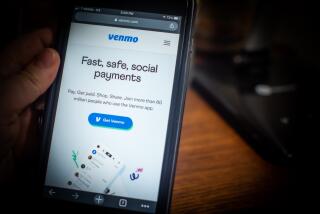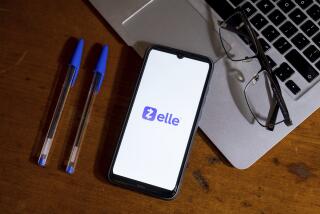Venmo and Zelle are trying to stop you from sending money to the wrong person
When Michael OâNeil tried to pay the company that inspected the Chicago condo he bought last summer, he had no idea there was a company on the East Coast with a nearly identical name and an email address that differed by just four letters â until he sent $360 to the wrong business.
OâNeil, 37, sent the mobile payment using Zelle and has spent the last year trying to get the money back.
âIt was my mistake, but one that I thought was immediately protected,â he said. âFour letters shouldnât cost youâ $360.
Consumers want to be able to send and receive money as instantly as they can an email, whether theyâre splitting the bill at a restaurant or sending allowance to their kids. Tech companies and banks met that desire with products such as Venmo and Zelle. But lost in the excitement over the new technology was the understanding that instant payments donât have the same protection as credit card transactions.
In other words, if a user sends money to the wrong person, itâs the senderâs responsibility â not the companyâs.
Customers may expect banks to be able to retrieve their money, but Zelle payments are treated like cash. Thereâs only so much financial institutions can do to get that money back. In its user agreement, Zelle recommends that users not send money to people they donât know.
Venmo says it does not take responsibility for actions of recipients and doesnât guarantee identities of users.
Still, the mobile payment operators are adding some warnings after learning that customers are more prone to mistakes than they anticipated.
Last year, Venmo gave users the ability to add profile pictures to their accounts, introduced automatic flags that pop up if the sender doesnât know the recipient and added other measures to try to slow down users before they hit send. Early Warning Services, the bank-owned consortium behind Zelle, expects its partner banks to roll out pop-ups or alerts by the end of the month that ask users to confirm theyâre sending money to the right person.
Users often are sending each other $5 or $10 for pizza or beer, and those transactions add up. Zelle processed $32 billion in payments in July through September, up 67% from the same period last year, according to Early Warning, which is based in Arizona. More than 75 million email addresses and phone numbers are enrolled in Zelle, which has its own app and can be offered through banksâ apps or systems. Zelle also processes corporate disbursements, such as insurance payouts, which are included in its numbers.
Venmo processed about $17 billion in payments during the same period this year, up 78% from the year-earlier period. The company, which PayPal acquired in 2013, does not release user numbers.
Some users have learned their lesson about misdirected payments.
When she was fresh out of college, Melissa Rohman was at a happy hour with new work acquaintances. Someone with âa very generic nameâ picked up the tab, she said. Rohman found a Venmo account with that name, typed in some emoji and sent off about $10.
âI keep tabs on my bank account pretty regularly, and I was noticing that it hadnât gone through,â said Rohman, 23.
She sent the money to the wrong person.
The user on the receiving end of Rohmanâs $10 didnât accept it, and the money was later refunded. But the temporary loss of that $10 was enough to slow down the Elmhurst, Ill., resident when she sends money. Now, Rohman makes sure sheâs transferring money to the right person via Venmo. She checks the other userâs profile picture, puts the personâs number in her phone and asks for direct confirmation that the profile she chose is the right one.
âIf I know that itâs not for certain them, I just wait and ask them,â she said. âI donât want to be giving out money to people I donât know.â
Chicago resident Amy Baxter, 27, also has resorted to her own analog security measures after sending $5 to the wrong person to cover her share of a beer pong game with co-workers.
âI hold up my phone and Iâm like, âIs this you?â â she said.
When Early Warning launched Zelle last year, it thought consumers would use the product to send money to friends and family â people already in their contact lists, said Lou Anne Alexander, the companyâs group president of payment solutions.
âWe thought it would be mom, sister,â she said. âI donât think we realized how many folks would actually type in a cellphone number, for instance, as opposed to pulling it from someone [they] already know.â
Users assume that banks can get their money back if itâs sent to the wrong person, just as unauthorized credit card charges are often refunded. But that sort of protection is paid for through annual fees or other charges, whereas Zelle is free, Alexander said.
She declined to provide data on the number of misfires Zelle users have experienced or the amount of money theyâve sent to the wrong people.
âIt wasnât a lot of them, but when they happen, theyâre painful, and consumers like to talk about it,â Alexander said. âThey get really mad if their money goes somewhere and they donât see it.â
For Zelle users, that anger is amplified because itâs a bank-backed entity thatâs handling the money, said Sarit Markovich, a clinical associate professor in the strategy department at Northwestern Universityâs Kellogg School of Management. Venmo users, on the other hand, might not expect the PayPal-owned company to be able to get them their money back, Markovich said.
âConsumers just expect from banks more than they would expect from a [smaller] company, specifically when youâre thinking about protecting your money,â she said.
And it doesnât matter to users that Zelle is free, Markovich said. They assume theyâre getting certain protections since theyâre already paying other bank fees.
To be clear, Zelle users are covered if theyâre victims of fraud. Banks have a good-faith obligation to help the consumers get their money back, but sometimes itâs outside their control, Alexander said. For example, people who receive money sent in error might not agree to have that money taken out of their accounts.
OâNeil still contacts JPMorgan Chase every few months in hopes of finding an associate who can help him get his $360 back from the East Coast home inspection company. His attempts to get his money back from the company directly also have been unsuccessful.
âEveryone seems a bit dumbfounded,â he said. âIf people are making large purchases ⌠and thereâs this kind of room for error, you would think more mechanisms are in place to protect consumers in this day and age.â
More to Read
Inside the business of entertainment
The Wide Shot brings you news, analysis and insights on everything from streaming wars to production â and what it all means for the future.
You may occasionally receive promotional content from the Los Angeles Times.










